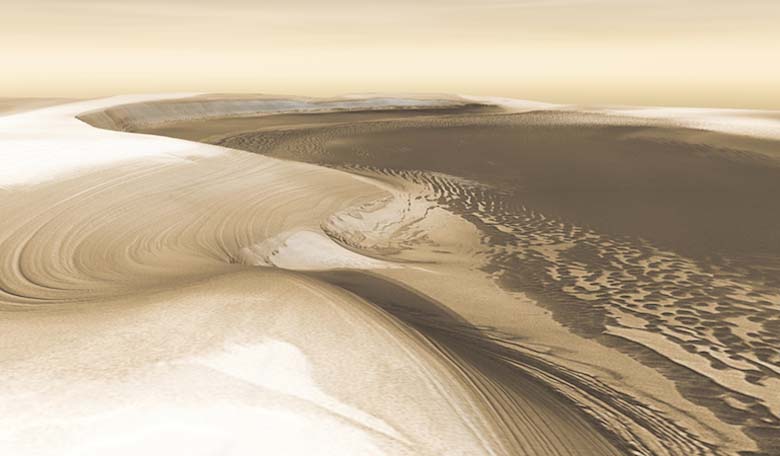Radar measurements of Mars' polar ice caps taken with NASA's Mars Reconnaissance Orbiter (MRO), reveal that the mostly dry, dusty planet is emerging from an ice age, that ended about 400,000 years ago.
Models have suggested that Mars has undergone ice ages in the past, but observations of the martian landscape to confirm this has been sparse. As ice erodes through interactions with wind, it can create spiral troughs and other distinct features. Scientists can reveal changes in ice accumulation and flow, thus inferring changes in the Red Planets past climate, by tracing the layers of these features within the ice.
With the aid of data from MRO's Shallow Subsurface Radar (SHARAD), researchers have been able to analyse variations in the layer properties by producing images known as radargrams that are like vertical slices though the layers of ice and dust at the martian poles.
Along with identifying a boundary in the ice that extends across the entire north polar cap, researchers were able to trace layers that accumulated very quickly and uniformly above the boundary, compared with the irregularity of layers below them.
"The layers in the upper few hundred meters display features that indicate a period of erosion, followed by a period of rapid accumulation that is still occurring today," said planetary scientist Isaac Smith, the study's lead author. Smith led the work while at Southwest Research Institute in Boulder, Colorado, but is now at the Planetary Science Institute in Tucson, Arizona.
The retreat and regrowth of polar ice on Mars is due to the increased tilt of the planet. As poles become warmer than lower latitudes, the polar caps retreat and water vapour migrates toward the equator, forming glaciers and ground ice at mid-latitudes. Conversely, polar ice begins accumulating again as the warm polar period ends, and it is this changeable ice coverage that Smith and colleagues see in the record revealed by the SHARAD radar images.
Models predict that following a Martian ice age that ended about 400,000 years ago, polar deposits would have thickened by about 300 meters (980 feet). This is in agreement with the upper unit identified by Smith and colleagues, which reaches a maximum thickness of 320 meters (1,050 feet) across the polar cap and is equivalent to a 60 centimetre thick global layer of ice.
"This suggests that we have indeed identified the record of the most recent Martian glacial period and the regrowth of the polar ice since then. Using these measurements, we can improve our understanding of how much water is moving between the poles and other latitudes, helping to improve our understanding of the Martian climate," said Smith.











